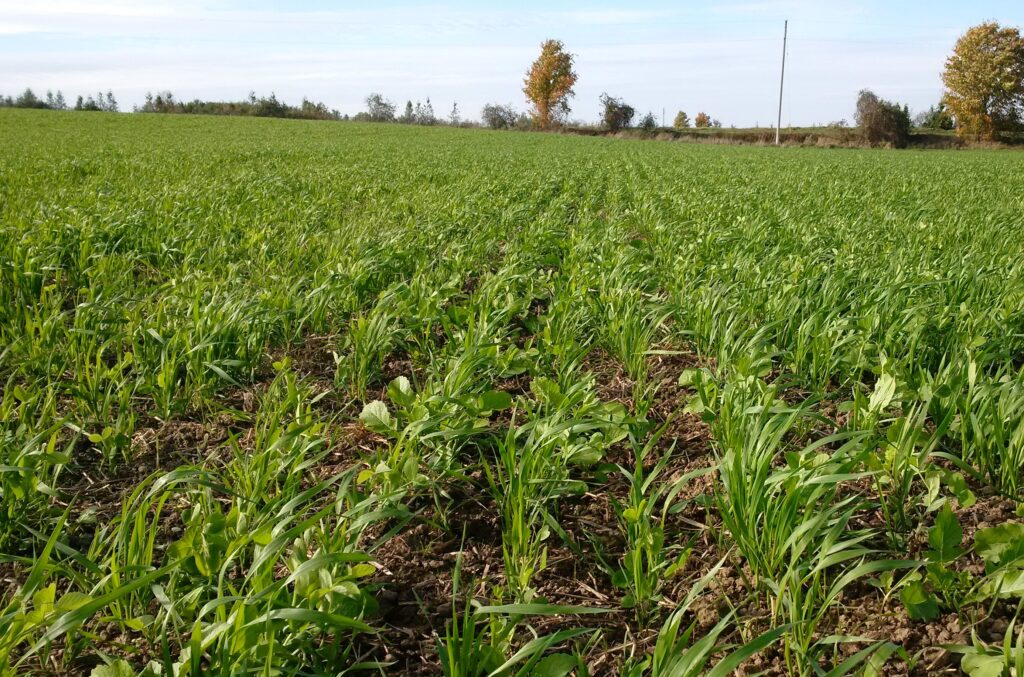With winter wheat harvest beginning in parts of the province, cover crop seeding will be close on its heels. Adoption of cover crops has increased in Ontario over the last number of years, and for good reason – they help improve water infiltration, compete with weeds, and capture left-over nutrients. In this article, I’ll share some tips for achieving success with cover crops after wheat, especially if you’re new to cover cropping.
Begin with the end in mind
The first step is to decide on your goal for growing the cover crop and how you want the field to look next spring. Is your main goal to smother weeds or to scavenge nutrients? Select your species, seeding rate and method accordingly. For example, if reducing soil erosion over winter is a main goal, you may drill species that will provide lasting residue, such as oats at a reasonable rate (e.g. 45-60 lbs/ac), and possibly add a winter cereal to the mix.
It’s also critical to plan your termination method and timing before seeding. If you’re new to cover crops, seed species that will winterkill.
Use the Midwest Cover Crop Council’s Decision Tool to match species and planting information to your specific goals and for guidance on cover crop termination.
Manage wheat residue
Next, manage wheat residue and volunteers as well as possible. Ensure straw is either baled or that both straw and chaff are spread evenly across the full width of the header. Delaying seeding to spray volunteer wheat can be beneficial, as it will reduce competition with your cover crop. If seeding as quickly as possible is important to you, consider controlling volunteer wheat with a herbicide application in the fall.
Keep it simple
Third, keep it simple. While some growers seed 4, 6 or 10 species in a mix and have success, it’s not necessary to grow that many species to see soil benefits from cover crops. In fact, depending on your goal, planting just one or two species may work best. If you’re new to cover crops, I recommend seeding a simple mixture of oats and radish (Figure 1) or oats and peas. Peas in the mix will fix some nitrogen, while radish will grow quickly, compete with summer annual weeds, and may help to break through some compaction. It’s recommended to wait until August to seed a mix containing radish. Aim for 30-60 lbs/ac of oats and no more than 2 lbs/ac of radish.

Figure 1. An example of a simple cover crop mixture containing oats and radish.
Click here for an oat-radish recipe for Ontario from the Midwest Cover Crop Council.
Less is more
Finally, when it comes to seeding rate, less can be more. Cover crops like oats, radish or winter cereals do not need to be seeded at high rates to achieve good growth. This is particularly true if the cover crop is drilled in a timely fashion, and you have high fertility soils or manure is applied. Experienced cover croppers have found that seeding on the lower end of recommended ranges – unless you’re growing livestock feed or targeting erosion protection – keeps costs lower and can make planting simpler the following spring. See below for seeding rate ranges for common species and mixes (Figure 2).

Figure 2. Cover crop seed rate chart for common species and mixes.
Summary
Benefits from cover cropping occur through consistency. By following these tips, you will be more likely to have a positive experience and continue seeding cover crops into the future. More advanced techniques to address specific cropping goals can be evaluated and added on over time. Stick with your program and be patient as you watch your soil improve.
Resources
Midwest Cover Crop Council’s Decision Tool